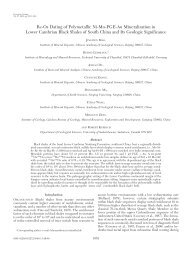Uranium Ore Deposits
Uranium Ore Deposits
Uranium Ore Deposits
Create successful ePaper yourself
Turn your PDF publications into a flip-book with our unique Google optimized e-Paper software.
WEITERBILDUNG<br />
In-situ solution mining reverses this process by forcing an<br />
oxidized environment on the reduced uranium ore deposit<br />
whereby uraninite is dissolved.<br />
Hydrothermal mobility of uranium requires an oxidized<br />
environment of fluid circulation. Note that the term<br />
„hydrothermal“ refers to any kind of warm water, without<br />
a genetic connotation. Oxidized conditions exist only<br />
since about 2.4 Ga when the Earth‘s atmosphere first developed<br />
oxygen levels in the percent range. There are no<br />
hydrothermal uranium deposits prior to this period, but<br />
there are magmatic enrichments of uranium in granites<br />
and granite pegmatites throughout the history of Earth.<br />
<strong>Uranium</strong> behaves as incompatible element in felsic melt<br />
systems, i.e. is not incorporated into the major silicate minerals,<br />
and becomes enriched in residual melts. Prior to<br />
2.4 Ga, uraninite with high thorium content from erosion<br />
of such rocks was an insoluble heavy mineral and became<br />
enriched in fluviatile placers, such as the Witwatersrand,<br />
South Africa, or Blind River/Elliott Lake district,<br />
Canada. Such uranium placers only formed in the Archean<br />
oxygen-free environment. Under recent atmospheric<br />
conditions, uraninite dissolves easily in rain water, and the<br />
erosion of uranium deposits, or even uranium-rich granites<br />
(10-20 g/t U), produces broad secondary dispersion halos<br />
which are used for finding uranium ore. The high<br />
solubility of uranium under oxidizing conditions even<br />
at low temperatures allows enrichment under arid to<br />
semi-arid weathering conditions where uranium can be<br />
precipitated due to evapotranspiration. In this environment,<br />
hexavalent uranium is fixed commonly together<br />
with potassium and vanadium, and then<br />
forms a number of deep yellow to green minerals<br />
such as carnotite [K 2<br />
(UO 2<br />
)V 2<br />
O 8 · 3H 2<br />
O] and tyuyamunite<br />
[Ca(UO 2<br />
)V 2<br />
O 8 · 5-8½ H 2<br />
O] (Fig. 5). The predominance of uranium<br />
vanadates in these deposits is due to the low solubility<br />
of U-V compounds compared to all other (UO 2<br />
) 2+ minerals.<br />
<strong>Uranium</strong> is variably enriched in igneous rocks due to its<br />
large ionic size and charge which does not allow incorporation<br />
of uranium into the major rock-forming minerals<br />
during crystallization. <strong>Uranium</strong> is similar in its physicochemical<br />
properties to thorium, and both elements become<br />
enriched in residual melts during crystal fractionation.<br />
Particularly granitic rocks are enriched in both elements<br />
and provide a reservoir for leaching by warm water.<br />
However, thorium is much less soluble than uranium<br />
which is why hydrothermal uranium deposits have low Th<br />
contents. There are also igneous rocks which are so highly<br />
fractionated that uranium (and thorium) reach ore grade,<br />
i.e. a few hundred g/t. Such rocks are pegmatites and leucogranites,<br />
as well as highly alkaline rocks.<br />
Major uranium deposit types<br />
<strong>Uranium</strong> deposits form in a very wide range of geological<br />
environments. Historically, vein-type deposits were<br />
the most important, as well as paleoplacers. These mineralization<br />
styles tend to be relatively low grade (commonly<br />
< 1 % U), and the discovery of high-grade unconformity-<br />
Fig. 4: <strong>Uranium</strong> ore from the Bertholène deposit (mined out) in the Massif<br />
Central, France. This granite breccia consists of hematitized granite fragments<br />
(red), cemented by thin uraninite rims (black), followed by pyrite (yellowish), and<br />
demonstrates the change in oxidation state of the system from oxidized (hematite)<br />
to reduced (pyrite). Uraninite is precipitated during this change in redox conditions.<br />
The ore occurs near the unconformity of weathered Hercynian granite<br />
of Carboniferous age and overlying Permian coal-bearing strata of Permian age.<br />
(Sample collection Lehmann).<br />
.<br />
Fig. 5: <strong>Uranium</strong> ore from weathering and evapotranspiration:<br />
Tyuyamunite, a hydrated Ca-U-vanadate, in Carboniferous<br />
limestone, Prior Mountains, Wyoming, USA.<br />
(Sample collection Lehmann)..<br />
Ausgabe 02 | 2008<br />
www.advanced-mining.com<br />
19










